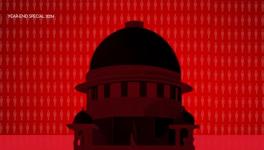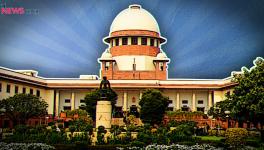SC Reserves Decision on Whether Mere Organisation Membership is Offence Under UAPA

Section 10 of the UAPA penalises the membership of an organisation declared unlawful under the Act. This is inconsistent with a 2011 decision of the Supreme Court, which had struck down the principle of guilt by association.
—-
A three-judge bench of the Supreme Court comprising Justices M.R. Shah, C.T. Ravikumar and Sanjay Karol on Thursday reserved its order on the issue of whether mere membership of a banned organisation under the Unlawful Activities (Prevention) Act, 1967 (UAPA) is sufficient to constitute an offence under Section 10 of the UAPA.
The issue arose in the aftermath of a two-judge bench decision of the Supreme Court in Arup Bhuyan versus State of Assam (2011) in which Justices Markandey Katju and Gyan Sudha Misra, while acquitting the appellant, read down Section 3(5) of the Terrorist and Disruptive Activities (Prevention) Act, 1987 (TADA) to mean that mere membership of a banned organisation would not make a person a criminal unless they resort to violence or incite people to violence, or create public disorder by violence or incitement to violence.
In the Arup Bhuyan case, the constitutional validity of Section 3(5) of TADA was not under challenge. This is one of the major arguments advanced by Solicitor General of India, Tushar Mehta, on behalf of the Union Government, that the court could not have read down section 3(5) in the absence of any challenge to its validity, and more so when Union government was not even heard in the matter.
On Section 10 of the UAPA, Mehta urged the court to give a literal interpretation to it. Mehta submitted that if Lashkar-e-Taiba is a banned organisation, a person cannot say they are just a member and has a right to remain a member.
Article 19(1)(c) of the Constitution confers all citizens to the right to form associations or unions. Referring to Article 19(4), Mehta contended that this right is not absolute. Article 19(4) states that the State can, by law, impose reasonable restrictions on the right to form associations or unions in the interests of the sovereignty and integrity of India or public order or morality. Mehta thus argued that Section 10 rightly penalises mere membership of a banned organisation.
Section 10 reads as follows:
- Penalty for being member of an unlawful association, etc.- Where an association is declared unlawful by a notification issued under Section 3 which has become effective under sub-section (3) of that section,-
(a) a person, who
(i) is and continues to be a member of such association; or
(ii) takes part in meetings of such association; or
(iii) contributes to, or receives or solicits any contribution for the purpose of, such association; or
(iv) in any way assists the operations of such association,shall be punishable with imprisonment for a term which may extend to two years, and shall also be liable to fine; and
(b) a person, who is or continues to be a member of such association, or voluntarily does an act aiding or promoting in any manner the objects of such association and in either case is in possession of any unlicensed firearms, ammunition, explosive or other instrument or substance capable of causing mass destruction and commits any act resulting in loss of human life or grievous injury to any person or causes significant damage to any property,
(i) and if such act has resulted in the death of any person, shall be punishable with death or imprisonment for life, and shall also be liable to fine;
(ii) in any other case, shall be punishable with imprisonment for a term which shall not be less than five years but which may extend to imprisonment for life, and shall also be liable to fine.”
Mehta vehemently contended that the 2011 judgment did not keep the security of the nation intact. He argued that Section 10 is also preventive in nature, not just punitive. Criticising the 2011 order, Mehta said Indian courts need not follow American jurisprudence wherein fundamental rights are absolute, unlike India, where reasonable restrictions on fundamental rights are provided by the Constitution itself.
Distinguishing the Supreme Court’s judgment in Kedar Nath Singh versus State of Bihar (1962), Mehta said this judgment dealt with the penal offence of sedition and was not applicable to Section 10 of the UAPA.
“You need not sympathise when the nation declares an organisation as unlawful or a terrorist organisation,” Mehta submitted.
On the other side, senior advocate Sanjay Parikh, for the interveners, argued in support of the 2011 decision of the Supreme Court in Arup Bhuyan. He contended that since 1960, there had been many judgments that held that there must be overt acts of incitement to violence or violence before a person can be prosecuted. He submitted that the element of mens rea (the mental state of knowledge or intention of wrongdoing that constitutes a crime) is important to prosecute a person.
On the argument of the government that the court could not have read down Section 3(5) of TADA in the absence of any challenge to its validity and without hearing the government, Parikh said that the three-judge bench may say that the method of the two-judge bench was wrong, but still agree with the observation made by it. Parikh also averred it was not correct to say that American judgments are not applicable and could not be relied upon in India. He added that human rights and civil liberties have always been part of Articles 19 and 21 of the Constitution.
In the 2011 order in Arup Bhuyan, the division bench had relied upon the decision of the same bench in State of Kerala versus Raneef (2011). In the latter, the court had agreed with the U.S. Supreme Court decision in Elfbrandt versus Russell (1966), which had rejected the doctrine of ‘guilt by association’.
This interpretation led to the Union government and the Assam government filing review petitions and an application seeking clarification of the judgment. In August 2014, the Union government submitted before the court that it was not questioning the acquittal of the appellant Bhuyan, but was only concerned with the interpretation of the court to read down Section 3(5) of the TADA in the absence of the Union government being party to the case.
Both the Union and the Assam governments contended in 2014 that the interpretation accorded to Section 3(5) of the TADA had been adversely affecting the interpretation of Section 10 of UAPA which provides for penalty for being a member of an unlawful association. It was submitted by the government that after the Supreme Court’s decisions in the Bhuyan case and in Sri Indra Das versus State of Assam (2011) (also, co-incidentally, delivered by the same division bench of Justices Katju and Misra), trial courts and high courts were relying on them by giving emphasis on the facet of mens rea.
The Union government was aggrieved by the judgment in the Arup Bhuyan case because it believed that when any provision in Parliamentary legislation is read down, in the absence of the Union government, it is likely to cause enormous harm to the interest of the State as in many cases, certain provisions have been engrafted to protect the sovereignty and integrity of India.
On August 26, 2014, a division bench of the Supreme Court comprising Justices Dipak Misra and Abhay Manohar Sapre had referred the matter to a larger bench without framing any issue.
Get the latest reports & analysis with people's perspective on Protests, movements & deep analytical videos, discussions of the current affairs in your Telegram app. Subscribe to NewsClick's Telegram channel & get Real-Time updates on stories, as they get published on our website.
























